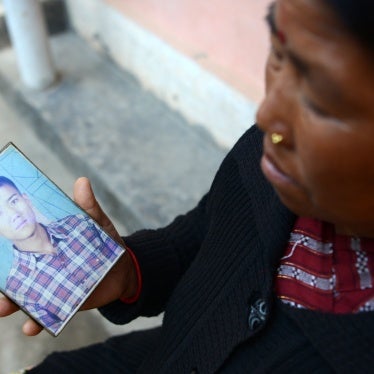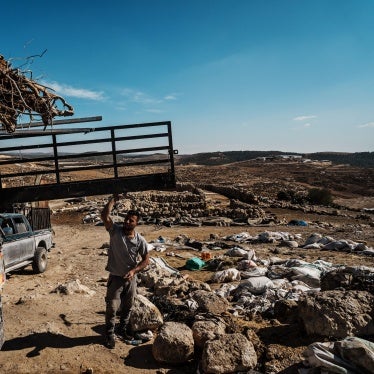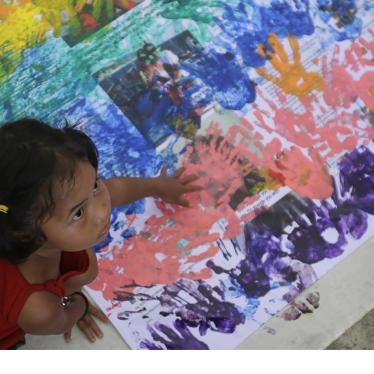Dear Datuk Hajiji,
Human Rights Watch is a nongovernmental organization that monitors and reports on human rights in over 90 countries around the world. We have documented the human rights situation and advocated for human rights in Malaysia for more than 30 years.
Human Rights Watch is conducting research into the impact of the Nature Conservation Agreement (NCA) in Malaysia entered into between Hoch Standard PTE Ltd. (“Hoch Standard”) and the government of the state of Sabah on Indigenous communities in Sabah and whether affected communities were properly consulted prior to signing the agreement. We would value an opportunity to include information from the Sabah state government to clarify some issues in our research. We have several questions that we hope your office can answer to help ensure the accuracy of our reporting.
Background
On October 28, 2021, Hoch Standard and the State of Sabah reportedly signed a Nature Conservation Agreement (NCA) covering 2 million hectares of land in Sabah, starting with an initial 600,000 hectares of land. Under the agreement, which lasts for 100 years and is renewable for another 100 years, Hoch Standard is given the exclusive right to develop nature conservation management plans and to manage the “Natural Capital Benefits” in those areas. The agreement also grants Hoch Standard the exclusive right to manage and monetize “Natural Resources” in the areas included. Natural Resources are defined as “Natural Capital,” which is turn is defined to include “carbon credit and non-carbon credit components of natural capital but shall not include any physical timber extraction, oil and gas and other natural resources.”
Since the existence of the agreement was disclosed in an article in the publication Mongabay on November 9, 2021, Sabah state officials and representatives of Tierra Australia, which reportedly brokered the agreement, have given conflicting statements about the binding nature of the agreement and the need for or existence of prior consultations with Indigenous communities living within areas that are or would be covered by the agreement.
We have a number of questions about the agreement, which are set forth in the annex to this letter. Please reply by March 28, 2022, so that we can reflect your responses in our reporting. Any responses or comments that you make will be reflected in our reporting as appropriate, and we may publish your responses at our discretion and when appropriate, either in full or in part.
Sincerely,
Brad Adams
Executive Director, Asia Division
Human Rights Watch
cc:
Jeffrey Kitingan
Deputy Chief Minister
State of Sabah
Frederick Kugan
Chief Conservator of Forests
Sabah Forestry Department
ANNEX: Questions for Sabah State Government
A. Status of the Agreement
- Is the Nature Conservation Agreement (NCA) signed by the parties legally binding?
- Are any elements of the agreement still under negotiation? If so, what elements are still under negotiation?
- Have the locations of the first 600,000 hectares of land covered by the agreement been identified? If so, please list the areas covered by the agreement and provide a map of, or the geographic coordinates of, those areas.
- If the land has not yet been identified, when and how will that identification be made?
- Have the areas of land that will subsequently be covered by the agreement been identified? If so, please list those areas and provide a map and/or the geographic coordinates of those areas.
- If the land has not yet been identified, when and how will that identification be made?
- It has been reported that the NCA will include only areas that have already been designated Class 1 protected areas. Is that correct?
- How many people have been identified as residing on the land that is covered by the agreement? What are their rights to the land, under Malaysian law?
- Has the government conducted an environmental and social impact assessment of the NCA? If so, please share the assessment. If not, why not?
- If the government has not yet conducted an environmental and social impact assessment, does it plan to do conduct one?
- If so, when will that assessment take place?
B. Scope of the Agreement
- What is your understanding of what is included in the terms “Natural Capital” and “Natural Resources”?
- The Sabah Biodiversity Enactment (2000), enacted by the Sabah state legislature on December 29, 2020, requires financial benefit-sharing agreements with “native and local communities” for any use of biological resources on lands over which those people have rights and/or associated relevant knowledge.[1] Associated relevant knowledge under that law means “any innovation or individual or collective practice with actual or potential value associated with biological resources contained therein.”[2] Under the NCA, will Indigenous traditional and other relevant knowledge be recognized and financially compensated in the event that Natural Capital associated with Indigenous Peoples (such as medicinal or food plants) is monetized? If so, please provide the specific language from the NCA on that issue.
- If not, why not?
- Have there been any discussions relating to how traditional knowledge would be recognized and financially compensated for in the event that currently unforeseen value may be extracted from the conserved areas in the future?
- If these discussions did occur, please specify who was present in the discussions and any agreements that were reached.
- Under the United Nations Declaration on the Rights of Indigenous People, Indigenous peoples have the right to maintain, control, protect, and develop their cultural heritage, traditional knowledge, and traditional cultural expressions, as well as the manifestations of their sciences, technologies and cultures, including human and genetic resources, seeds, medicines, knowledge of the properties of fauna and flora, oral traditions, literatures, designs, sports and traditional games, and visual and performing arts. They also have the right to maintain, control, protect, and develop their intellectual property over such cultural heritage, traditional knowledge, and traditional cultural expressions. The Declaration calls for states to take effective measures in conjunction with Indigenous peoples to recognize and protect the exercise of these rights.[3]
- Does the NCA ensure protection of such rights? If so, how does the agreement do so? If not, why not?
C. Consent of and Consultations with Affected Communities
Under the UN Declaration on the Rights of Indigenous Peoples, Indigenous peoples have to give or withhold free, prior, and informed consent for the use of their land or resources, and have a right to redress if their land and resources are used, damaged, or taken without such consent.[4] Under the UN Guiding Principles, business enterprises “should respect the human rights of individuals belonging to specific groups or populations that require particular attention, where they may have adverse human rights impacts on them,” including adhering to UN instruments that have elaborated on the rights of Indigenous peoples, among others.[5] This would include respecting the right of Indigenous peoples to free and informed consent prior to the approval of any project affecting their lands or territories or other resources.[6]
The Sabah Biodiversity Enactment (2000) requires prior informed consent from “native and local communities” for any use of biological resources on lands over which those people have rights and/or associated relevant knowledge.[7]
Identification of Impact and Affected Communities
- How will the NCA impact ownership, management, exclusion, alienation, use or access-rights of Indigenous or other communities residing on, or dependent on, the land covered by the agreement?
- In determining the possible impact of the NCA on Indigenous and other communities, what factors were considered? Did you consider the possible impact on cultural heritage, traditional knowledge and practices, access to and use of natural resources, and food security and livelihoods?
- If the government has not identified the possible impact of the NCA on Indigenous communities, why has it not done so?
- Has the Sabah state government identified the Indigenous and other communities that might be affected by the NCA?
- If so, how did you make that determination?
- Please list all Indigenous and other communities that, in your assessment, may be affected by the NCA.
- If the government has not yet identified the Indigenous and other communities that might be affected by the NCA, when and how do you intend to make such a determination?
Consultations with Affected Communities
- Has the Sabah state government consulted with the Indigenous communities that might be affected by the NCA about the possible impacts of that agreement? When did those consultations take place?
- If the government has not engaged in consultations, why has it not done so?
- Does the government intend to engage in such consultations in the future? If so, when does it plan to do so?
- If the government engaged in consultations, how did you identify the relevant members of each community with whom to consult? If the government has not yet engaged in consultations, how does it intend to identify the relevant members of each community with whom to consult?
- Please identify the specific members of each affected community with whom you consulted.
- Please provide minutes, summary, or any other document outlining the proceeds from the consultation.
- What steps did you take to ensure that women and other marginalized groups within each community were involved in the consultation? If the government has not yet engaged in consultations, how does it intend to ensure that women and other marginalized groups within each community are involved in the consultations?
- Precisely what information did you give the community representatives regarding the planned NCA?
- Did you specify the scope of the “natural resources” included within the agreement? If so, how did you define that scope?
- Was it communicated in writing or orally? If in writing, in what language(s)?
- Please provide documentation of the information provided to communities regarding the planned NCA.
- If you have not yet engaged in consultations, what information does the government intend to give community representatives regarding the planned NCA?
Consent from Affected Communities
- Did the Sabah state government obtain formal consent for the project from each of the Indigenous communities that it determined might be affected?
- What process was used to obtain a community’s consent? How was the consent documented?
- How did the government confirm that those giving consent had the authority to represent the community?
- If the government has not yet obtained formal consent for the project from each of the Indigenous communities that might be affected, does it plan to obtain such consent before the project proceeds?
- If so, what process does the government intend to use to obtain and document that consent?
- Does the Sabah state government have a process for conflict and complaint resolution that aligns with United Nations Declaration on the Rights of Indigenous Peoples? Under the declaration, states are to "establish and implement, in conjunction with indigenous peoples concerned, a fair, independent, impartial, open and transparent process, giving due recognition to indigenous peoples’ laws, traditions, customs and land tenure systems, to recognize and adjudicate the rights of indigenous peoples pertaining to their lands, territories and resources, including those which were traditionally owned or otherwise occupied or used. Indigenous peoples shall have the right to participate in this process.”[8]
[1] Sabah Biodiversity Enactment (2000), section 24A(1) (“An applicant for a licence for access to a biological resource or associated relevant knowledge, for commercial or potential commercial purposes shall enter into a benefit-sharing agreement with the resource provider”); section 24A(2) (“A benefit-sharing agreement shall be based upon mutually agreed terms and provide for fair and equitable benefit sharing.”). https://sabc.sabah.gov.my/sites/default/files/uploads/attachments/2019-11/SabahBiodiversityEnactment2000.pdf.
[2] Sabah Biodiversity Enactment (2000), section 2.
[3] United Nations Declaration on the Rights of Indigenous Peoples, resolution adopted by the UN General Assembly on September 13, 2007, available at https://www.un.org/development/desa/indigenouspeoples/wp-content/uploads/sites/19/2018/11/UNDRIP_E_web.pdf, art. 31.
[4] See UN Declaration on the Rights of Indigenous Peoples, arts. 28 & 32.
[5] UN Guiding Principles on Business and Human Rights, commentary to principle 12.
[6] See UN Declaration on the Rights of Indigenous Peoples, art. 32(2).
[7] Sabah Biodiversity Enactment 2000, section 24A(1) (“An applicant for a license for access to a biological resource or associated relevant knowledge, for commercial or potential commercial purposes shall enter into a benefit-sharing agreement with the resource provider”); section 24A(2) (“A benefit-sharing agreement shall be based upon mutually agreed terms and provide for fair and equitable benefit sharing.”). https://sabc.sabah.gov.my/sites/default/files/uploads/attachments/2019-11/SabahBiodiversityEnactment2000.pdf.
[8] UN Declaration on the Rights of Indigenous Peoples, art. 27.






